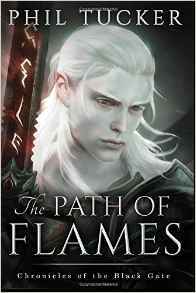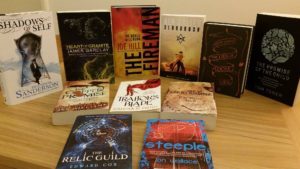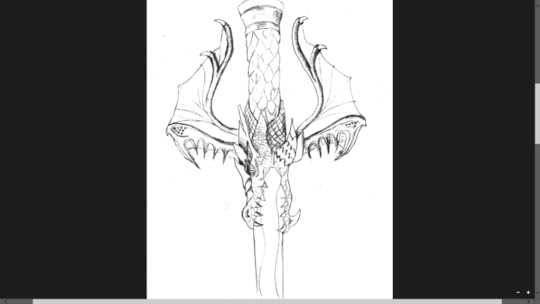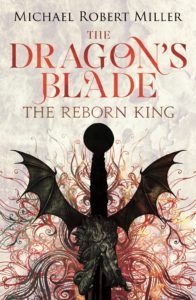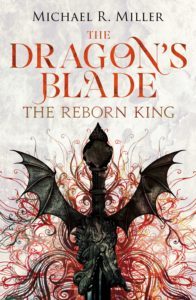Michael R. Miller's Blog, page 3
January 8, 2017
Writing Journeys – Laura M. Hughes
Laura is one of those people beloved by authors. I don’t know anyone else who promotes others work so enthusiastically, and she’s a successful author herself. Her novella, Danse Macabre, is picking up 5 stars across the board. I read it around Halloween and it was the perfect spooky read. If you want to be creeped out, then best to go read it. And now, over to Laura!
 ‘The road goes ever on and on…’
‘The road goes ever on and on…’
So says Bilbo; and the same is true for my work-in-progress, currently titled simply Ashwake. An epic fantasy series influenced by the works of Joe Abercrombie, Steven Erikson, Terry Pratchett and Mark Lawrence, Ashwake is the story I’ve always wanted to tell, but have never quite found the words to write.
For years, I carried the seeds of Ashwake inside me; I was excited and proud to do so, especially once I announced its conception to the world. ‘When’s it due?’, ‘What’s the sex?’, ‘Who’s the father?’ – questions that no one ever asked me, but which indicate the sort of expectant impatience that would soon begin to stress me out when I discovered that my story’s gestation period would be much, much longer than I could’ve anticipated.
NaNoWriMo 2013 was the first time I ever put fingers to keyboard. I was rather taken with my half-baked story about two dreamy male travelling companions: one, a graceful warrior; the other, a loveable rogue. (The fact that this had already been done to death did not deter me in the slightest).
I was, as a friend of mine would say, ‘enthusiastic’; that month (my ‘honeymoon period’ with NaNo) I bashed out 60K words about the adventures of Kylo and Finn. Then I forced myself to sit on my hands for a month before eventually returning to it, eager to re-read the sheer brilliance of what I’d written.
Ah, 2013-Laura. You sweet summer child.
My ‘manuscript’ was shit.
With growing horror – and embarrassment – I revisited every awkward dialogue, every tired trope and every cheesy stereotype. No longer were my protagonists a source of pride and delight. The rose-tinted glasses were cracked, and truth’s harsh light hurt my eyes.
As it happens, a few months earlier I’d started a blog (The Half-Strung Harp). After my messy breakup with NaNo (and the obligatory aftermath of self-piteous wallowing) I pulled myself together and switched my focus to non-fiction reviews, as well as weekly lists like Tough Travels.
Things went well for a while. I began to dabble in writing again and even wrote a story titled Danse Macabre (which I later self-published as a novelette) which won a writing competition on a book forum I frequented. But when a long period of tumult in my working life dragged me into an even-worse-than-usual bout of depression, I shut down my blog once and for all.
Thankfully, I soon became involved with the Fantasy-Faction group on Facebook. A friend and beta reader, Kareem Mahfouz, persuaded me to apply to join the review team; before long I was not only writing reviews for Fantasy-Faction but also helping them with the 2016 Self-Published Fantasy Blog-Off (SPFBO).
The fantasy community has inspired me tremendously. Having such a positive and wide-ranging network of support (in addition to a handful of gorgeous individuals with whom I can talk to in depth about various aspects of writing, reading and life in general) has proved critical not only to my success but to my wellbeing . . . which, in my mind, is far more important.
Stephen King said that if you don’t have time to read then you don’t have time to write. I’d also venture to say that the writer who exists as an island is likely to create fictions that are less inclusive, less relevant, and much more harmful than the writer willing to open their mind and interact with the folks they’re writing for.
My manuscript has evolved – flourished, even – along with my own expanding awareness of societal issues such as diversity; in particular, the representation of race and gender in genre fiction. Every time I revisit a scene or a set of notes, therefore, my perspective is different. I myself am constantly adapting, changing, growing (I hope) more mindful as a result of daily interactions with fellow readers and writers. Every day I’ll see, or hear, or read something that makes me question everything I’m doing; it’s these ideological changes, no matter how minuscule, that I try to focus on when revising my story – not ‘let’s go hunt for a better verb’, or ‘this MS could really use less semicolons.’
Of course, I still cringe when I read my own work. And (of course) I still waste precious minutes (*cough* hours) browsing Thesaurus.com. But I’m learning that that’s part of the process; that the answer isn’t just ‘toss it all and start afresh’, but to take the time to find which bits are causing the cringe and why, and then to alter or remove them.
I’ve also thrown chronology out of the window. I enjoy constructing stories in a non-linear way, in this case selecting a character who appeals to me at the time of writing and then choosing a scene from the overarching plot summary to begin work on. (Scrivener helps a lot with this, because it enables me to summarise each scene using the corkboard feature and then rearrange them at my leisure. I like the call this ‘the patchwork quilt’ method.*)
(*I’ve never made a patchwork quilt. I’m operating under the assumption that it’s like piecing together a big, floppy jigsaw.)
To sum up: there was a time when I thought that ‘learning the craft’ meant getting a handle on (e.g.) what makes a ‘good’ book; who’s who in the publishing industry; what’re the most fashionable literary techniques, and how to ‘master’ social media platforms like Twitter. Now, I realise that learning the craft is inseparable from learning the world.
In case anyone thinks I’m dissing NaNo: I’m not. National Novel Writing Month is a great concept and a brilliant midwife that has helped ease thousands of great stories into the wide world. For me, though, it induced me before I was ready; and while I am still trying hard to manage my Ashwake time more effectively, I’ve also accepted the fact that like so many things in life, it’ll be ready . . . when it’s ready.
In the meantime, I’ll continue to work on other projects alongside it. A novella about a gang of thieves, several poems and a couple of short stories are just a few examples of things I currently have on the go, as well as plans for a darkly humorous serial featuring a Jalan Kendeth-esque protagonist.
As for where Ashwake is up to right now . . . well, let’s just say that the original incarnations of Kylo and Finn are dead, buried, dug up again, burned and scattered to the winds.
But Cailoh and Fin? Watch this space . . .
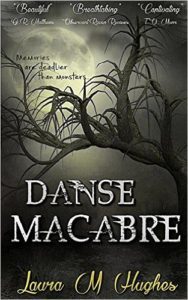 Laura M. Hughes was born and raised beneath the grey pigeon-filled skies of Rochdale, northern England. As a child she enjoyed collecting insects, reading about insects, and looking at pictures of insects.
Laura M. Hughes was born and raised beneath the grey pigeon-filled skies of Rochdale, northern England. As a child she enjoyed collecting insects, reading about insects, and looking at pictures of insects.
Shortly after turning twelve she experienced a life-changing event: the cinematic release of The Fellowship of the Ring, which smashed through the French windows of her imagination like a fantastical half-brick and let in all sorts of new and exciting ideas.
She currently spends her days working, reading, and faffing about with numerous writing projects. In her spare time she can be found at home switching off lights in the rooms her husband has been in, as well as foiling frequent assassination attempts by their four crafty cats. Oh, and writing reviews over on fantasy-faction.com!
Tomorrow we’ll be hearing from Jen Williams, author of the witty and action packed Copper Cat Trilogy, and the upcoming Ninth Rain.
Sign up and get the Dragon's Blade for FREE!
January 7, 2017
Writing Journeys – Peter Newman
Today we have Peter Newman, winner of the David Gemmell Morningstar Award for best debut novel in 2016. That novel was The Vagrant. I first met Pete one evening at the Super Relaxed Fantasy Club in London. He was reading that night from his second book, The Malice, and having a central character who does not speak was oddly compelling. It wasn’t like anything I’d read or heard before, and it’s little wonder readers have been drawn to his unique work. So, over to Pete!
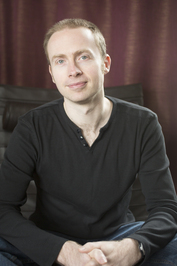 Pete’s Journey Into Publishing
Pete’s Journey Into Publishing
A bit of me has always fancied being a writer. Growing up, I loved Weiss and Hickman’s Dragonlance books, and when I discovered that they had started life as a role-playing game I was thrilled.
I run role-playing games, I thought. I’ll just run a game and turn that into a book. Simple!
And so, in my twenties, that’s exactly what I did. I ran a game, recorded the sessions and then started typing them up into a book.
To cut a long story short: it’s not simple.
I made two major mistakes at this point. The first one was that I hadn’t appreciated how a lot of the things that are fun for a player in the game are not necessarily fun for a reader. As a player you’re in the experience and so in an action sequence every twist and turn of that fight or car chase is exciting, even if it does go on for three hours. Also, things that are funny in a room with your friends are often not funny on paper.
The second error was that as soon as I’d written my first twenty thousand words or so I was so pleased with myself that I immediately showed it to some friends for feedback, where what I should have done was kept writing. As a budding author, I wanted some encouragement and was hoping they would say something like: ‘This is amazing! Write more! I can’t wait for the next bit!’ Yes, I had a fragile ego and it needed a bit of boosting. Writing is hard, you know?
Anyway, the feedback I got was fair, reasoned and critical. It was also all true.
I didn’t write again for about ten years.
During this time I continued being creative but never with my own material. I was a drama teacher, so it was in my job, and I played and ran quite a number of RPG’s. Also, I got married. Like me, Emma had always fancied being a writer but, unlike me, when she really sets her mind to something, there are few forces in the world that will stop her.
We’d talk about her ideas for books over coffee. She’d share early drafts with me and we’d spend hours discussing plot and character. And it felt great! For me, it was like all the fun bits of being a writer without the work or fear of failure.
Then, one fateful day, she turned to me and said: ‘I think you’re a frustrated writer.’ And she was right.
I started writing again immediately and frenetically. I felt that I’d been a fool, that I should have been doing this for years, and that I’d wasted time. I wrote regularly and often, however I was feeling. If nothing else, rage put me in front of the keyboard every day.
I wrote a book. Well, I wrote a manuscript. I showed it to Emma. Sadly, she did not say anything about how I should be submitting it to publishers and agents or how it was the best thing she’d ever read. In fact, what she said was: ‘Well done darling. You’ve written a book. Now go and write another one.’
Reader, I’m happy to say that our marriage was strong enough to survive this bombshell. The thing was, that first book was just me trying to figure out how to write a book.
So I wrote a second book.
And a third one. This one showed promise so I got some test readers to look at it (they were fab) and rewrote it extensively based on their feedback.
These books weren’t submitted either.
Throughout this time I’d joined a flash fiction community and had been working on a serial that had grown out of a piece of flash fiction about a silent man wandering a demon infested post-apocalyptic landscape with a baby and a goat. I came to realise that this was actually a novel, and, later, that it was actually a trilogy.
And when Emma looked at it, she said, ‘This is it, this is the one.’
And though it was painful getting to this point, Em actually saved me a lot of time. If she hadn’t been honest with me, I would have polished and submitted the very first book I wrote (the really rough one) and it would have been rejected.
So now I had a manuscript ready to submit but I didn’t know enough about the process so I started going to conventions, attending every panel I could and making absolutely sure I went to everything on submissions and getting an agent. This was super useful. It was also really good attending before I needed to actually impress anyone and just get a sense of what authors do at conventions.
Appropriately armed, I began the submissions process, being sure to follow each agent’s individual guidelines to the letter.
After that, things happened fairly fast. I submitted my manuscript in August 2013, signed up with my agent in December of that year, and was offered a deal with Harper Voyager in January 2014 for The Vagrant and its sequel, The Malice.
I could stop the story here as at this point I had journeyed ‘into publishing’. However, like with most things, the journey didn’t really stop there, or at least a slightly different one started. Since then I’ve been contracted to write a tie-in novel for fantasy MMO Albion Online, and Harper Voyager signed me up for the third and final book in the Vagrant series, The Seven, due out in April 2017.
They’ve also just bought my new trilogy, The Deathless, which I’m working on now.
So, good times!
In some ways, my life feels utterly different to what it was three years ago but in others, it hasn’t changed. I’m still driven to write. Criticism, positive or otherwise has a profound effect on me, and most of the time creating anything worthwhile is hard. But it’s also joyful, even if it doesn’t always feel like it at the time! Certainly, nothing gives me the same sense of achievement, of having got something done, as having written a new scene or chapter.
And yet it could easily not have happened. I’m pretty sure that without Emma my writing journey would have ended in my twenties and I’d have been forever unfulfilled on some level as a result.
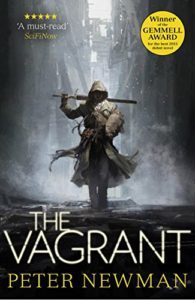 Peter Newman co-writes the Hugo nominated and Alfie Award winning Tea and Jeopardy podcast and is also the voice of the butler, Latimer. He writes for Fantasy MMO Albion Online, including the tie-in novel: LANDFALL. His debut novel, THE VAGRANT, was published by Harper Voyager and won the David Gemmell Morningstar Award for best newcomer in 2016. Book two, THE MALICE, is out this year*, with book three, THE SEVEN due in 2017.
Peter Newman co-writes the Hugo nominated and Alfie Award winning Tea and Jeopardy podcast and is also the voice of the butler, Latimer. He writes for Fantasy MMO Albion Online, including the tie-in novel: LANDFALL. His debut novel, THE VAGRANT, was published by Harper Voyager and won the David Gemmell Morningstar Award for best newcomer in 2016. Book two, THE MALICE, is out this year*, with book three, THE SEVEN due in 2017.
There are also two shorter stories set in the same world, available as ebooks. THE HAMMER AND THE GOAT (which is set parallel to THE VAGRANT) and THE VAGRANT AND THE CITY, which is set between books 2 and 3 (coming early 2017).
*THE MALICE will be released in March 2017 in the US
Tomorrow we’ll be hearing from Laura M. Hughes, a writer for Fantasy Faction and author of the stunningly well received novella Danse Macabre.
Sign up and get the Dragon's Blade for FREE!
January 6, 2017
Writing Journeys – Phil Tucker
So it begins…
It is with my great pleasure that I kick start this series. For those who missed yesterday’s post, I’ve invited an army of fantasy authors to tell us about their writing journeys. From humble beginnings to world domination, we should get it all over the next few weeks. Hopefully, it will inspire you as Phil’s post inspired me. Without further ado, over to Phil Tucker, author of The Path of Flames.
 There was almost six feet of snow outside when I came my closest to giving up this whole writing gig. I was deep into the brutally cold winter of ’12, locked away in a drafty small house in Western Mass, my car reduced to a hump amongst the snow banks, the roads like black ice, the sky the inside of a chalky kettle. My wife had reconciled herself to spending entire days alone as I locked myself away to write. I was desperately trying to find the end of Book 3 of a dystopian vampire trilogy. I’d funded it with a Kickstarter, had set up everything I knew to ensure success, and I couldn’t finish the damn thing.
There was almost six feet of snow outside when I came my closest to giving up this whole writing gig. I was deep into the brutally cold winter of ’12, locked away in a drafty small house in Western Mass, my car reduced to a hump amongst the snow banks, the roads like black ice, the sky the inside of a chalky kettle. My wife had reconciled herself to spending entire days alone as I locked myself away to write. I was desperately trying to find the end of Book 3 of a dystopian vampire trilogy. I’d funded it with a Kickstarter, had set up everything I knew to ensure success, and I couldn’t finish the damn thing.
Worse, when I finally crawled across the finish line, it was only by cutting Book 3 into two. I was burned out and broken. I published Book 1 to no acclaim, no fanfare, and no sales. Book 2 failed to change things a month later. Book 3 didn’t even cause a ripple when I dropped it into the ocean that is Amazon. I’d wrecked myself writing those books and, at my height, I was making about $25 a month from their sales.
I tell you, I nearly gave it all up right there. I fell into a funk, a deep funk that the coming of spring and summer barely alleviated. I couldn’t even force myself to write Book 4. Years of work had come to naught. My life’s passion seemed to have withered and died.
“You need to connect with other writers,” my wife said during one of my black depressions. “Go to conventions. Ask them how they do it.”
I scoffed. I might even have harrumphed. I turned away. I didn’t need anybody to tell me how to write. I was wounded and proud, disconsolate and irritable. And then one beautiful morning my wife came out of the bathroom with stars in her eyes and told me I was going to be a father. Everything changed, the world shifted on its axis, and I decided I would do everything and anything to make this writing thing work.
So I reached out. I came down from my ruined tower and started reading forums online. We moved back to Florida to be with our families, and while moving I discovered the Writer’s Café on KBoards. And I learned about mailing lists. I learned about launch strategies. I learned about promotional services, the importance of honing your blurbs, how to get reviews before your book goes live. In short, I realized that I’d only been wearing one hat. The writer’s hat. And that all along I should have been wearing two.
So I devoured everything I could read, success stories, musings, conspiracy theories as to how Amazon’s algorithms worked, autoresponder sequences to hook your readers close, everything and anything. And I put on my marketing hat and did the next obvious thing: I launched a female pen name and dived into Paranormal Romance.
This was during the height of Kindle Unlimited 1. Amazon was paying you by downloads, not page counts, so if you could publish two novella’s a month in a hot genre, you would make bank. I rolled up my sleeves and wrote my first werewolf romance. We needed cash, I’d always loved werewolves ever since playing Werewolf: The Apocalypse, so it all made sense.
And I crashed and burned. I didn’t know the rules. The tropes. I focused on plot and not enough on relationships. My characters didn’t have enough depth. So I rolled up my sleeves even higher and tried again. And again. And finally, something clicked.
November ’13 I made more than I’d made all year. Then that December I tripled what I’d made in November. January I made a killing. It was surreal.
My daughter had been born that August. My world turned upside down, but even through that sleep deprivation and craziness, I kept writing. I’d get up at 5 a.m. and drive to work. I’d get there early, fire up the office lights, make some coffee, and write hot werewolf action till 8:30. Then I’d smile and greet everybody as they walked in, do my job till 5 and head home. Afternoons, evenings and nights were spent with my family. Not much sleep. But regardless of how many times my daughter would wake up, I’d peel myself with a groan out of my bed at 5 and head back to work.
Maybe I overdid it. Halfway through January something in my system broke and suddenly I was sick. I saw a series of specialists and none of them could tell me what was up. Writing became an ordeal. My momentum teetered. Finally, I self-diagnosed myself as having developed a wicked gluten intolerance. I cut out everything delicious and clawed my way back from the edge.
But I’d lost my stride. I’d burned out on werewolves and PNR. My income continued strong into that summer, but my heart wasn’t in it. And my readers could tell. My sales tapered. KU1 became KU2. My model broke down, and finally I sat back and decided my PNR run had come to an end.
But what next? I was now armed with all kinds of knowledge. I knew how to launch. How to market. What worked and what was a waste of time. Better yet, my stint writing PNR had honed my writing skills. My characters had a new level of interiority and depth that they’d never had before. I appreciated the importance of their relationships. How if you broke their hearts just right, you just might break your reader’s heart as well.
My wife and I decided to leave Miami. We wanted to get out of the big cities and return to the countryside. So we decided on Asheville, North Carolina. We geared up to move, and I thought long and hard about what to write next. Under my own name, I decided. No more pen names. But what? Go big or go home, I thought. Go back to your roots. Tackle those books you always loved but never thought you’d have the chops to write. David Gemmell/Raymond Feist/Guy Gavriel Kay/Elizabeth Moon kind of books. Not just fantasies, but epic fantasies. Something you could sink your teeth into. Something I could write forever.
So we packed up our house and I started dreaming up worlds. Started asking questions that led to more questions. Started taking notes, creating characters, mapping out journeys, both external and internal.
It took me about three months to come up with the world of The Chronicles of the Black Gate and about two months to write it. My beta readers were amazing and helped me knock out the kinks. I was on fire. I stole time where I could find it to write. I stopped watching shows, reading books, going for walks, brushing my teeth, going to sleep. I sacrificed every minute so that I could both spend time with my daughter and write 160,000 words.
Then I pulled together all my launching skills and fired that sucker into the massive world of Amazon. And to my unending delight it took off. Better than I’d ever dreamed. It hung in there, sticky like all get out, and people liked it. They wrote amazing reviews. I started to get lovely emails. My mailing list began to grow.
To cap off my wonderful launch, I got an aw-shucks kind of review from Pornokitsch who selected me to progress to the final round of the Self-Publishing Fantasy Blog Off competition. This led to meeting a bunch of other great writers, forming my first ever online community, and connecting with new readers.
But I didn’t waste any time. I got to work on Book 2 and published it about two months after Book 1 had gone live. Did all the right promo’s, and it blew up again. Huzzah!
Now it’s October ’16 and I’ve just finished Book 3. It’s 100,000 words longer than I expected. That threw me for a loop. But I doubled down, shades of trying to finish Book 3 of that original vampire dystopia haunting me, remembering those harrowing cold days of chasing an end that wouldn’t come.
But this time I knew what I was doing. I found The End two days ago. My editor’s expecting the MS tomorrow, and I’ll publish it by the end of the month. And I won’t rest. I won’t stop. I’ll barrel on through to Book 4. Gotta keep throwing wood in the fire.
It’s been a heck of a journey. But throughout it, I’ve been fueled by my love of writing and my family. There’s nothing you can’t do if you want it bad enough. And I want nothing more than to become a full-time author.
Phil Tucker is one of the great success stories of the 2016 Self-Published Fantasy Blog-Off (SPFBO) and is a current finalist. His epic fantasy series Chronicles of the Black Gate is ongoing with three books published. The Path of Flames is the first book in the series.
Join me again tomorrow when we’ll be hearing from Gemmell Morningstar Award winning author, Peter Newman!
Sign up and get the Dragon's Blade for FREE!
January 5, 2017
Fantastical Writing Journeys
So this whole thing kind of ran away from me….
But what is it, you ask? What’s in store for everyone? Well, I’ve invited other authors to open up a bit about their writing ‘journey’; where they started, what they’ve gone through, and how it’s all led to their current project. It’s a rather broad topic and each author has tackled it in their own unique way, as all good writers do.
It all began when, in a moment of wild abandon, I asked Phil Tucker, author of the explosive debut Path of Flames, for a guest post on this very topic. At the time I was looking to write more guest posts myself and I thought, hey, why not get some more guests on my own site. I’d been reading another gushing review of Phil’s book and so my first reaction was just to ask him. Phil was kind enough to write me a piece. It was one of the most moving things I’d ever read.
Yep, a blog post the man wrote in about half an hour moved me in a way many books and films have never come close to. It was intimate, it was laced with emotion, and it told his story. So I thought that it would be interesting to hear from other authors about their ‘journeys’ in writing, their stories. I also found Phil’s post inspirational, as I’m sure many of you will when you read it. And this led me to a real awareness of an aspect of publishing that we all know but often forget. That is, not every superstar or success story simply sprang into existence. It can be encouraging to remember that everyone essentially starts as a rogue typist, bashing away at the keyboard with only the dream of authorhood fuelling them.
So I decided to go and ask more authors to contribute posts. Some are indie authors and some are traditional. Some are big names and some are just starting out. In fact, the response I received was quite unexpected and I’d like to thank everyone for taking the time to write something for this series.
The plan is to release one post per day.
You can see the authors involved below. They’re in a scheduling order but this may be subject to change as we progress. However, we will be kicking things off with Phil Tucker’s excellent post tomorrow so be sure to check back for it!
The Authors
Phil Tucker
Peter Newman
Laura Hughes
Jen Williams
Dyrk Ashton
Mark Stay
Ben Galley
Anna Smith-Spark
G. R. Matthews
Mark Lawrence
Timandra Whitecastle
Steven Poore
More Authors (dates TBC)
Benedict Patrick
Miles Cameron
Graham Austin-King
J.P. Ashman (Jonathan)
Steven Kelliher
James Barclay
John Gwynne – TBC
Tom Toner
Josiah Bancroft
Sign up and get the Dragon's Blade for FREE!
January 2, 2017
BookNests Huge Charity Auction
I’ve posted about this fantastic book auction before but I want to draw attention to it again. For those who don’t know, Booknest is a Fantasy book review site and one of the reviewers there, Petros, has rounded up 100 (yes that’s right, 100) fantasy authors to donate signed books. These books are all up for grabs.
How do you get a chance to win some? By simply donating £1. That single pound will get you a chance to win one of six batches of 10 signed and personalised books delivered straight to your door. This lottery will be open until the 10th of January.
What about the remaining 40 books? Well they will be set up in more batches to be bid on, with all proceeds going to charity. Other than Worldbuilders, I can’t think of another charity auction where so many great books are available.
Where is the money going? All proceeds raised will be donated to Doctors Without Borders (aka Médecins Sans Frontières). They provide emergency medical care worldwide to people affected by conflict & disasters. Those who work with them are out there right now, while the rest of us are still recovering from holiday food overdoses. In fact they contacted Petros to actually thank him for arranging this:
We are so grateful that you are organizing the Booknest’s Fabulous Fantasy Fundraiser to raise funds for Médecins Sans Frontières. It sounds a really interesting project between readers and writers, with 100 authors pledging a signed copy of their work which can be won from New Years Day onwards.
It is individuals like you that ensure we can continue to provide emergency medical aid where it is needed most. Your hard work and effort shows solidarity with those we care for all over the world.
Kind regards,
Judie Hill
So it’s an excellent cause. And with the chance to win 10 personalised books for £1, what’s stopping you? You can click through and donate here
Thank you in advance to anyone who helps supports this fundraiser.
November 19, 2016
One Year Anniversary
The Dragon’s Blade: The Reborn King was published on November 16th 2015. It’s therefore been one full year. I suppose I ought to reflect on this milestone…
Have all my expectations been fulfilled? Well, in cold hard figures, no. I genuinely thought I had hammered my expectations into the ground before publishing but I haven’t quite reached them. I won’t reveal what they were, nor will I give out my sale numbers, partly in case I am laughed at or others feel put off in seeing them. It’s been enough to cover the cost of editing, proofreading, typesetting, formatting, cover design, purchasing ISBN numbers, distribution setup costs, domain name buying, the website – basically a lot of things you often don’t consider when budgeting for a book. Book 1 is therefore in profit. In that sense, I can hardly complain and I look ahead to book 2 optimistically.
Perhaps I could track my journey briefly for those who don’t know. I was in the middle of a law conversion course when I started to seriously write Dragon’s Blade. I had bits of it written but they were shockingly awful. It was always a distant dream. I decided I wanted to make it a reality. Really, it was a form of therapy for me. Back then I felt like I was drowning but having this goal gave me a focus and a purpose I’d lost. I started that venture back in January 2015, writing for a few hours each night once I got my law coursework out of the way. I began attending nights of the London Writers Café and my very first outing showed me I had a very long way to go. But I kept going and I kept writing and eventually something clicked. I found Acorn Independent Press in April by attending the London Writers Café (LWC). One night there was a panel on self-publishing and Acorn seemed to talk sense. The fact that the organiser of the LWC had invited them along gave me confidence as well. I finished the book in July and it came out in November.
Since then it’s been a year of terrific highs and crashing lows; something I think is common to most writers regardless of success. I have noticed that if there are a string of bad reviews a glowing one is just around the corner, and vice-versa. Sales can come in great waves before retreating from the shore, although a constant burn of activity in the form of reviews, interviews or guest posts can help regulate the tide. Keeping that up is hard going but it’s something I’ll have to try and do going forward.
I have of course received a good deal of help and support, and on occasion, a stroke of luck. Getting a Bookbub featured deal came out of nowhere. My cover will have helped in that arena, as it has in attracting people to the book in the first place. One thing is constant. Wherever I traipse the book around, jaws always drop at that cover. I have my editor to thank for that. Leila used to work in the traditional world and knew Rachel (the designer) from her time in it. Leila contacted Rachel and got her to look at the brief when I may not have been able to on my own. I was then lucky enough that my artist mother was able to sketch the sword. So, that’s three people right there that made just the cover alone possible. It goes to show that ‘indie’ authors really aren’t all that independent. Behind every book lies a team of people, some large, some small, but never the author completely alone. I’ve spoken at length about the importance of getting involved in the wider community in my post on conventions so I won’t repeat myself here. Basically, get out there!
Do I have any regrets? If I could go back in time and tell the Michael of one year ago something it would be to get his arse in gear gathering review contacts and indie bookstores. I now have a list nearly 500 names long (bloggers, booktubers etc.) but I didn’t put as much time into that as I should. I’d also tell myself about all the promotional services I’ve only started to discover recently. I was very naïve about the effort it would take to push this book in front of people. I also try not to think too much about what I did ‘right’ or ‘wrong’ in regards to the writing or content with my first book. It was the best book I could have written back in the summer of 2015. I’m sure I’ll think the same about book 2 once book 3 is wrapping up. Best to take these lessons and apply them on future projects.
As for the future, there is the rest of this trilogy to finish. Right now, The Dragon’s Blade: Veiled Intentions is with beta readers. There are more than double the number of them than I had for The Reborn King, so I’m hoping the process will be doubly rewarding. Hopefully, I will be starting to write book 3 before December rolls around. After that? Well, I have a side project that is already 40K words long and I’d like to finish it one day. While I am doing that, I can decide on which of the ideas bubbling away will become the next big one that takes up years of my life.
Because, frighteningly, it’s already been one whole year. I do hope I’ll be writing a similar post ten years from now…
Subscribe and get the Dragon's Blade for only £1
November 1, 2016
Why I go to Conventions
Thanks for stopping by the blog. Today it’s all about conventions (cons); why I go and why you should too. Be you a writer, published or unpublished, traditional or indie, or an avid reader, there are good reasons to go for everyone.
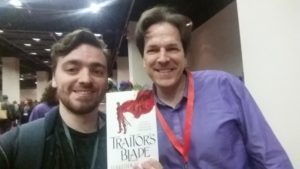 Now my experience is purely based on the UK and on relatively small-scale cons. If you’re from the US it will likely be different – not least because travel distances are vastly greater – however please stick around, as I imagine it’s much the same once you get there.
Now my experience is purely based on the UK and on relatively small-scale cons. If you’re from the US it will likely be different – not least because travel distances are vastly greater – however please stick around, as I imagine it’s much the same once you get there.
So why go? Well, the main reason is simple, and it has nothing to do with marketing, or selling or anything sleazy like that. Really it’s just to be sociable. Writers spend a lot of time on our own bashing away at a keyboard. Avid readers likely spend a lot of time sitting reading, by nature a solitary activity. We can connect online but it’s not quite the same as chatting to someone over a pint or coffee. Conventions began before the internet, to act as forums before there were such things such Facebook pages. It’s meant to be one big party. For an indie author this is even more important because you don’t have a treehouse of authors from your publisher you’re naturally a part of. Thankfully, virtually every author I’ve met through cons or related events are friendly. Noses aren’t turned up. In the end writers like talking to other writers; we like swapping stories, talking through sticky points we overcame (or need help in overcoming). And if you’re a reader? WRITERS WANT TO HEAR FROM YOU. There is nothing better than someone coming up and saying ‘hey, I liked your book’. So if you’re at a con and you notice your favourite author is in the room, feel free to go over and politely say hi. Politely being the key word there. Cons are tiring and for biggish authors working panels or signings all day it’s especially tiring. So bear that in mind.

Real life adventurer Miles Cameron
Which leads me to the next thing about cons. You can bump into some real mega stars, which is undeniably cool. Over the past year alone I’ve shaken hands with Brandon Sanderson (FantasyCon 2015), had a twenty minute workshop with Joe Abercrombie (GollanczFest 2016), had an awkward run-in with Joe Hill in men’s room, and drank with Scott Lynch and Elizabeth Bear (FatnasyCon 2016). I’ve also had the pleasure of being on a panel with Ben Galley (Nineworlds), someone I very much admire forging a name for himself in self-publishing. This also means ALL THE SIGNED BOOKS of the world. Here are a few…
 There are many more people I’ve met who have made these cons special but to name them would take up most of the blog post. It’s not just writers but editors, marketing folks, publicity people, booksellers, everyone that loves the genre. All of this means I feel I’ve made real connections in the community and can now actually have those interactions on social media, which every panel on self-promotion always says is so essential.
There are many more people I’ve met who have made these cons special but to name them would take up most of the blog post. It’s not just writers but editors, marketing folks, publicity people, booksellers, everyone that loves the genre. All of this means I feel I’ve made real connections in the community and can now actually have those interactions on social media, which every panel on self-promotion always says is so essential.
Do I sell my own books at cons? I have although interestingly the best one for that was a little non-book related one called GamesFest out in Tring in Hertfordshire. It’s nice to make some sales but really it shouldn’t be the point of going if you’re an author. You probably aren’t going to sell crazy amounts and it’s going to be far better for you if you spend your time in the bar area getting to know people than stuck behind a table in an expo hall. Depending on the con I’d be highly unlikely to claw back to the cost of a ticket, travel, accommodation, food, drink and the books themselves.

Marc Turner looking unimpressed
Which leads onto a downside. The unfortunate thing is cons have tickets and tickets cost money. This can range greatly depending on the size of the event and how far you book in advance but a £30-80 ticket for a weekend is quite normal. Tally up all you spend getting there and possibly staying nearby, and it can add up. Overall I’d say it’s absolutely worth it if you have the cash to spend. Think of it like investing in yourself. Once you consider the connections that will hopefully last years, coming away with great memories and stories then it begins to look like good value for money. I’m trying to be optimistic of course but you have to be in these things. One thing for sure is that if you sit around and do nothing, and meet no one, and don’t engage at all then your future looks bleak indeed.
Trade hall at GamesFest
So that’s why, even as an indie author, I go to cons. I hope I’ve helped nudge a few of you into deciding to go as well.
Subscribe and get the Dragon's Blade for only £1
October 8, 2016
This One’s From The Heart
I just had a feeling come over me to write this post, well, more of an update really. As many of you are hopefully aware, I am working on the edits for book 2 The Dragon’s Blade: Veiled Intentions.
So book 2 is coming.
The last few months have been especially busy. I was at 3 cons over August and September; I was interning for a month in September and trying to finish the draft of Veiled Intentions. I started it back in January.
Book 2 is eternally coming.
I know I am hardly in a position like poor George Martin – who has had hordes of readers banging on his door and flooding his inbox for years demanding he finish the next book – but I’ve developed an astonishing amount of sympathy for him over this year. Some people have been asking me for the next book though. I’m over the moon that people care enough to ask; that they want to read more and see how the story progresses.
So let me assure you, book 2 is coming.
I have fallen a little behind schedule. The aforementioned busy period coupled with a bout of bad health. For those who don’t know I have Cystic Fibrosis (a lung condition) and running around ragged like I’ve been isn’t always the wisest idea.
But book 2 is coming.
 There have been other things too, more personal and not things that need to be divulged. Needless to say it’s been a rough time but it’s not been all bad. Nineworlds was amazing and FantasyCon was even better. I feel more at home in the world of fantasy, writing and books than I did a year ago. Certainly more than when I travelled to Nottingham for my first ever convention last October, all bright eyed but woefully out of the loop.
There have been other things too, more personal and not things that need to be divulged. Needless to say it’s been a rough time but it’s not been all bad. Nineworlds was amazing and FantasyCon was even better. I feel more at home in the world of fantasy, writing and books than I did a year ago. Certainly more than when I travelled to Nottingham for my first ever convention last October, all bright eyed but woefully out of the loop.
Almost one year on and book 2 is close to being finished. I never thought I’d ever be able to say that. It was hard to write because now I understand when things aren’t working, so I stop and think and stress and worry and don’t simply plod on thinking I’ve got this nailed. Big changes were made. I think it’s a far better book for it.
So I’m excited for book 2. And come February 2017, I hope you will be too.
July 14, 2016
Designing a SPFBO Winner – Cover Creation For The Dragon’s Blade
In this year’s Self-Published Fantasy Blog Off (SPFBO), Mark Lawrence decided to hold a cover competition in addition to bloggers judging the books themselves. I was over the moon to discover that the cover for The Dragon’s Blade: The Reborn King had won both the judging and public vote. I thought I’d run through the process of making the cover so people can see what it is like for indie authors who have that extra level of involvement in cover design. You will also get to see some odd early versions!
Covers are always going to be crucial to a book’s success, especially for unknown authors. In the moment a potential reader looks at your book, a good cover should do three things. It should It should grab their attention, it should signal the book’s genre and it should give a feel for what sort of story it will be. In short, it should make them want to pick it up, or click through online, and read the blurb. So from the outset I was certain I wanted the Dragon’s Blade itself to feature on the cover. Not only would it scream FANTASY but it would also suggest there will be a fair bit of action and pace to the story.
I am also very fortunate to have an artist for a mother and she sketched out some ideas for the sword based off of my description. The result looked pretty damn awesome and worked as a great guide for the designer, Rachel Lawston. Rachel took her own approach but having a solid starting point meant the final design followed the same vision.
The Design Brief
In the design brief I got to suggest the approach we should take. Now, this is your chance as a self-publishing author to say exactly what you’d like the cover to be. Be specific. Make comparisons to other covers you like and describe an image clearly just like you would in your prose. Saying ‘I’d like a freaking cool looking sword please’ won’t help at all. Convey what mood and atmosphere you want to invoke. Most of all, take plenty of time to think on this. With everything taken into account my brief was just shy of one thousand words long.
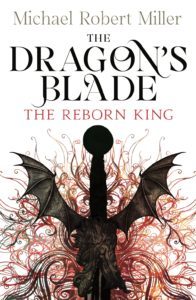 It is especially important to check out the competition in the categories you intend to place your book in. Go onto Amazon, Kobo and fall down the rabbit hole of browsing well past the top one hundred. Check out the fantasy sections in bookstores to see what has been coming out lately. In my brief I attached cover images of books by Trudi Canavan, Brandon Sanderson and Ben Galley as examples of the clean feel I was after as well as cover’s with swords such as John Gwynne’s Malice and Pawn of Prophecy by David Eddings, to use as guides. And while I say this is your chance to voice your opinion, do be reasonable. If your designer comes back with some alterations or recommendations then listen carefully. A good freelancer will have the experience of the genre and the industry to know what will and won’t work.
It is especially important to check out the competition in the categories you intend to place your book in. Go onto Amazon, Kobo and fall down the rabbit hole of browsing well past the top one hundred. Check out the fantasy sections in bookstores to see what has been coming out lately. In my brief I attached cover images of books by Trudi Canavan, Brandon Sanderson and Ben Galley as examples of the clean feel I was after as well as cover’s with swords such as John Gwynne’s Malice and Pawn of Prophecy by David Eddings, to use as guides. And while I say this is your chance to voice your opinion, do be reasonable. If your designer comes back with some alterations or recommendations then listen carefully. A good freelancer will have the experience of the genre and the industry to know what will and won’t work.
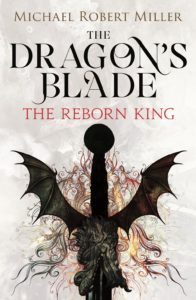 A few weeks went by and Rachel began sending over her ideas.
A few weeks went by and Rachel began sending over her ideas.
The Stages of Design
As you can see, this first image (on the left) takes the ‘clean’ look in mind with the white background. However, with such a busy bottom half I felt there was too much white space by comparison around the title. Removing the red and yellow swirl might have fixed that but I fell in love with it instantly. The Dragon’s Blade can emit fire and the intricate, beautiful pattern suggested flames without actually putting any in.
To the right, the second cover’s water-stained background helped even out the look but I felt having the subtitle in red drew too much attention to itself. It stood out because of the black lettering and dark handle on either side of it and made the eye jump to it first rather than the main series title.
The third version below combined the background I liked from the second cover and the imagery from the first. With the title in red, the eye was drawn to it first before being led down through the subtitle and into the design of the sword.
And yes, my middle name is Robert.
There were a few extra designs between this and the final cover but those were mostly small tweaks, in particular to add detail on to the pommel and handle of the sword, and lighten up the dragon head and blade itself so the image could be seen. We also flecked some extra black through the title so the red wouldn’t be too garish.
And that’s it. The final cover had arrived. It’s gorgeous and I was extremely lucky to land Rachel as a cover designer when I did.
Once again I’d like to thank Mark Lawrence for arranging the SPFBO for another year, all the bloggers who are taking part and to everyone out there who voted and is actively following the contest. The SPFBO is much more than a competition. It’s about highlighting the best practises of the indie world, bringing in new readers and letting other authors connect with each other and share information and ideas. To everyone whose book is still in the contest, I wish you the very best of luck!
Subscribe and get the Dragon's Blade for only £1
Designing a SPFBO Winner- Cover Creation For The Dragon’s Blade
In this year’s Self-Published Fantasy Blog Off (SPFBO), Mark Lawrence decided to hold a cover competition in addition to bloggers judging the books themselves. I was over the moon to discover that the cover for The Dragon’s Blade: The Reborn King had won both the judging and public vote. I thought I’d run through the process of making the cover so people can see what it is like for indie authors who have that extra level of involvement in cover design. You will also get to see some odd early versions!
Covers are always going to be crucial to a book’s success, especially for unknown authors. In the moment a potential reader looks at your book, a good cover should do three things. It should It should grab their attention, it should signal the book’s genre and it should give a feel for what sort of story it will be. In short, it should make them want to pick it up, or click through online, and read the blurb. So from the outset I was certain I wanted the Dragon’s Blade itself to feature on the cover. Not only would it scream FANTASY but it would also suggest there will be a fair bit of action and pace to the story.
I am also very fortunate to have an artist for a mother and she sketched out some ideas for the sword based off of my description. The result looked pretty damn awesome and worked as a great guide for the designer, Rachel Lawston. Rachel took her own approach but having a solid starting point meant the final design followed the same vision.
The Design Brief
In the design brief I got to suggest the approach we should take. Now, this is your chance as a self-publishing author to say exactly what you’d like the cover to be. Be specific. Make comparisons to other covers you like and describe an image clearly just like you would in your prose. Saying ‘I’d like a freaking cool looking sword please’ won’t help at all. Convey what mood and atmosphere you want to invoke. Most of all, take plenty of time to think on this. With everything taken into account my brief was just shy of one thousand words long.
 It is especially important to check out the competition in the categories you intend to place your book in. Go onto Amazon, Kobo and fall down the rabbit hole of browsing well past the top one hundred. Check out the fantasy sections in bookstores to see what has been coming out lately. In my brief I attached cover images of books by Trudi Canavan, Brandon Sanderson and Ben Galley as examples of the clean feel I was after as well as cover’s with swords such as John Gwynne’s Malice and Pawn of Prophecy by David Eddings, to use as guides. And while I say this is your chance to voice your opinion, do be reasonable. If your designer comes back with some alterations or recommendations then listen carefully. A good freelancer will have the experience of the genre and the industry to know what will and won’t work.
It is especially important to check out the competition in the categories you intend to place your book in. Go onto Amazon, Kobo and fall down the rabbit hole of browsing well past the top one hundred. Check out the fantasy sections in bookstores to see what has been coming out lately. In my brief I attached cover images of books by Trudi Canavan, Brandon Sanderson and Ben Galley as examples of the clean feel I was after as well as cover’s with swords such as John Gwynne’s Malice and Pawn of Prophecy by David Eddings, to use as guides. And while I say this is your chance to voice your opinion, do be reasonable. If your designer comes back with some alterations or recommendations then listen carefully. A good freelancer will have the experience of the genre and the industry to know what will and won’t work.
 A few weeks went by and Rachel began sending over her ideas.
A few weeks went by and Rachel began sending over her ideas.
The Stages of Design
As you can see, this first image (on the left) takes the ‘clean’ look in mind with the white background. However, with such a busy bottom half I felt there was too much white space by comparison around the title. Removing the red and yellow swirl might have fixed that but I fell in love with it instantly. The Dragon’s Blade can emit fire and the intricate, beautiful pattern suggested flames without actually putting any in.
To the right, the second cover’s water-stained background helped even out the look but I felt having the subtitle in red drew too much attention to itself. It stood out because of the black lettering and dark handle on either side of it and made the eye jump to it first rather than the main series title.
The third version below combined the background I liked from the second cover and the imagery from the first. With the title in red, the eye was drawn to it first before being led down through the subtitle and into the design of the sword.
And yes, my middle name is Robert.
There were a few extra designs between this and the final cover but those were mostly small tweaks, in particular to add detail on to the pommel and handle of the sword, and lighten up the dragon head and blade itself so the image could be seen. We also flecked some extra black through the title so the red wouldn’t be too garish.
And that’s it. The final cover had arrived. It’s gorgeous and I was extremely lucky to land Rachel as a cover designer when I did.
Once again I’d like to thank Mark Lawrence for arranging the SPFBO for another year, all the bloggers who are taking part and to everyone out there who voted and is actively following the contest. The SPFBO is much more than a competition. It’s about highlighting the best practises of the indie world, bringing in new readers and letting other authors connect with each other and share information and ideas. To everyone whose book is still in the contest, I wish you the very best of luck!

